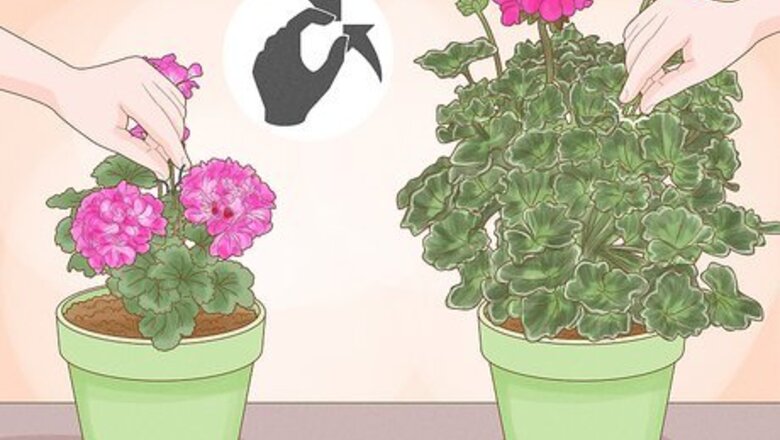
views
Knowing When to Prune
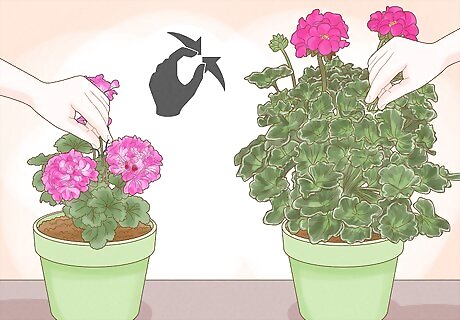
Pinch geraniums as soon as you bring them home. When you buy a new pot or flat of geraniums, pruning them immediately will encourage them to grow in a full, round, bushy shape. Be sure to remove dead flowers as well as any unhealthy leaves. Geraniums come in two varieties: "true" and "common." True geraniums are perennials, so pruning them is a good investment. Common geraniums are annuals, and they also do well with pruning, but since they won't last more than a season, it's not absolutely necessary to prune them.
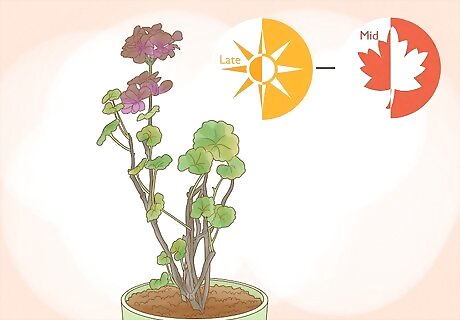
Prune geraniums in preparation for winter. After the growing season is finished, pruning back the geraniums will help them stay healthy and dormant during the colder months. Wait until the flowers have died and the geranium has gotten a little leggy, in late summer or early to mid-fall. This way the geraniums will conserve energy during the winter and spring back to life when the weather gets warm. If you live in a temperate climate where the winters don't get so cold that the ground freezes, you can overwinter your geraniums outside. In colder areas, where the ground freezes hard, you'll want to dig up your geraniums and keep them in pots indoors for the winter.
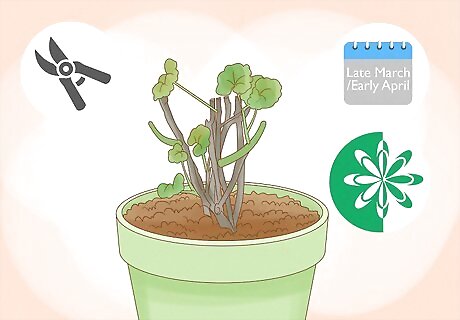
Prune overwintered geraniums in the spring. The geraniums will have continued to grow over the winter, sprouting long, woody legs. It's not a very attractive look, and that's why geraniums should be pruned right at the beginning of the new growing season. This will encourage them to grow in a full, pretty shape as the weather gets warm. If you overwintered your geraniums outside, prune in late March or early April, when the weather begins to warm up. If you overwintered your geraniums inside, wait until the ground has thawed. You can gradually get them used to outdoor weather by putting them outside during sunny, warm days and bringing them back in at night. When the last frost has passed, you can either transplant them to the ground or keep them outside in pots.
Using the Right Trimming Technique
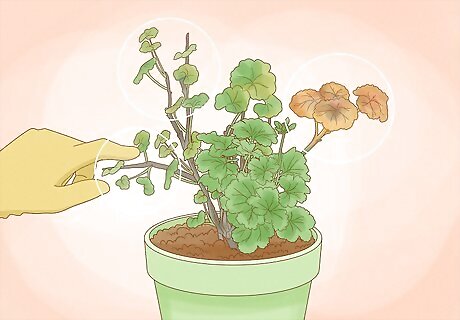
Examine the plant. Take a look at the plant from all angles so you can identify problem areas. Look for areas where there aren't many leaves, dead areas, and lopsided areas. Determine where you'll need to prune in order to give your geranium a healthier and more attractive shape. Pruning actually spurs new growth of stems and flowers, so trimming back a particular place won't necessarily leave a hole. If a large part of the plant is dead, you'll need to do some drastic trimming. The plant should survive as long as the central stalk is still green. However, it might take a few weeks before new leaves and flowers emerge.
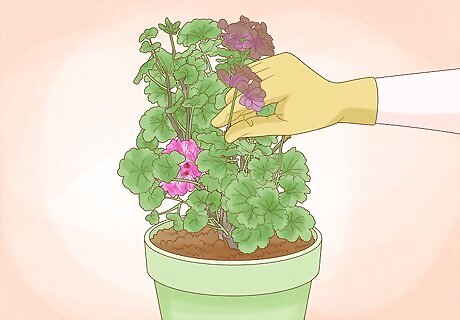
Deadhead the spent blossoms. This pruning method is an important way to encourage the plant to create new flowers. Taking off the dead blossoms allows the geranium to direct energy toward producing new ones. It also clears your view of the plant's stalks, so you can better see what you're working with. You can deadhead your geranium any time you see languishing blossoms; it's a quick way to maintain the health of the plant, and doesn't even require tools. Grasp the flower stem just behind the dead blossom with your thumb and forefinger. Pinch the stem and sever it with your thumbnail, then discard the dead flower. Alternatively, you may want to wait until a whole flower cluster is spent, then remove the whole cluster further down the stem down at the next leafy area.
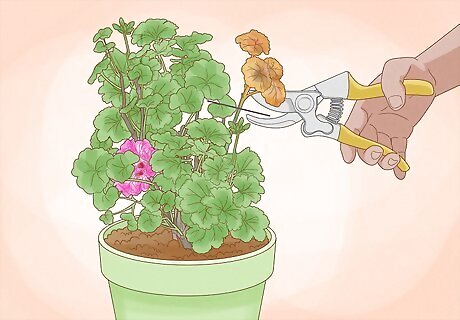
Remove dead foliage. The next step is to get rid of dead or dying leaves and stems. Trimming them back will keep the plant from wasting energy trying to keep them alive. Use a pair of hand clippers to trim dead or dying stems to the base of the plant. This is an important step to take in the spring in order to encourage good growth during the growing season, but you can trim back dead foliage any time of year. Don't bother trying to save foliage that seems on the verge of being dead, even if it's not quite there yet. It's better to trim it back and let the plant produce strong, new stems.
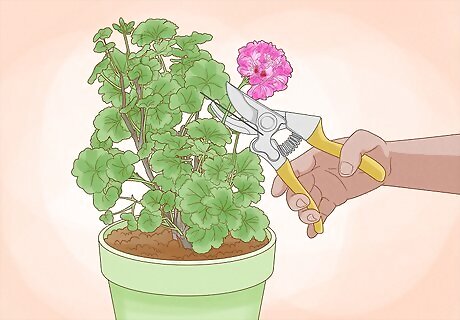
Trim healthy flower stems. In the spring, trimming back healthy flower stems will encourage the plant to produce more flowers. Follow a flower stem to where it's joined to the main stem, then use a pair of hand clippers to trim it against the base of the main stem. This will activate dormant buds and you should see new growth in no time. If you don't want to make such a drastic cut, follow the flower stem back to ⁄4 inch (0.6 cm) above the top of a node, which is a ring around the stem on a geranium. The new growth will sprout from the node.
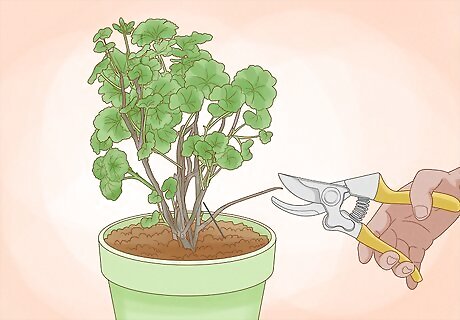
Trim back leggy stalks. "Leggy" stalks refer to those that have grown long and tall without any leaves, or with just a few leaves. Trimming these back almost to the base of the plant will allow it to produce new growth low down, creating a fuller, bushier look. Use a pair of hand trimmers to cut the stems close to the base, ⁄4 inch (0.6 cm) above the lowest node. Keep the cuttings for propagation! At the end of the growing season, trim back at least 1/3 of the plant in this way to prepare it for winter dormancy.
Propagating the Cuttings
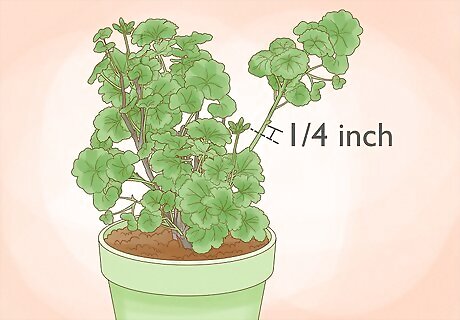
Trim the bottom of the cuttings. Hold a cutting upright and find the lowest node. Trim to ⁄4 inch (0.6 cm) below the node. Be sure to keep track of which end is up, since cuttings won't grow if you plant them upside down. Long cuttings can be trimmed into more than one piece. Just make sure each one is trimmed to ⁄4 inch (0.6 cm) below a node. Cuttings from flowering branches usually will not root, because they don't have the correct hormones in them to create roots. The cuttings need to be from growing stems, not from flowering ones.
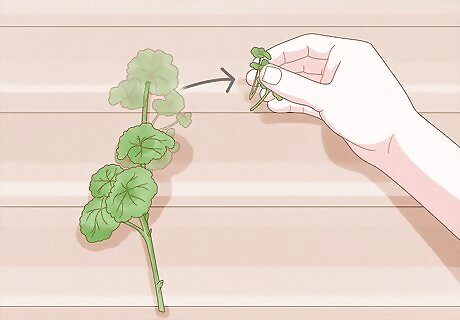
Remove all but the top leaf. The cutting won't be able to support all of the leaves of first, but keeping one will help the growth process along. Trim off the dead or dying leaves and try to keep one healthy leaf toward the top. If the cutting doesn't have a leaf, you can still plant it. If the cutting has one large, healthy leaf, use a scissors to make a slit in the leaf, leaving both halves attached. A cutting can't support the surface area of a large leaf.
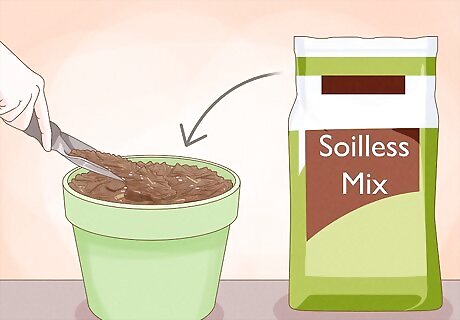
Fill a small pot with soilless mix. You shouldn’t plant cuttings in regular potting soil, as it will remain too wet and rot the roots. Choose one part coconut coir, peat moss, or vermiculite and mix it with one part perlite or sterile builders sand. You'll need a separate plastic or clay container for each cutting you want to plant.
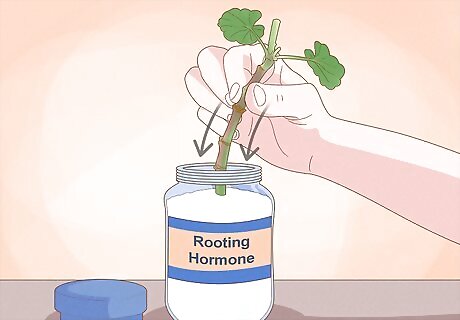
Dust cuttings with root hormones. Root hormones will help your geranium cutting flourish. Dip the bottom 1/4 inch (.64 cm) of the stem into rooting hormone and dust off the excess powder. You can find root hormones at the local garden shop, or online.
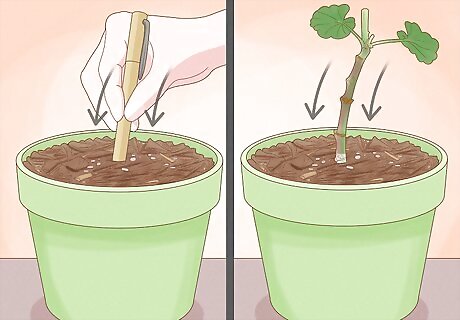
Plant the cutting. Use a chopstick or pen to make a hole in the potting soil, then insert the cutting bottom-side down. The tip of the cutting, including the leaf, should extend above the soil. Pat the soil lightly around the cutting.
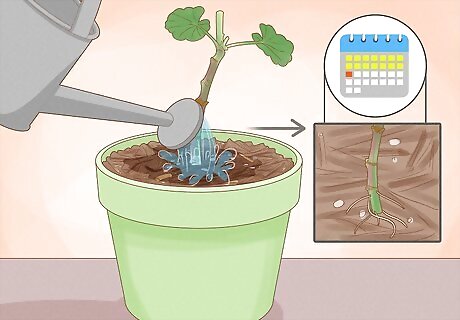
Water the cutting and wait for it to take root. After a week or two, it will begin to form roots. A few weeks later, new growth will appear. At this point, repot the cutting in garden or potting soil, or plant it in the ground.











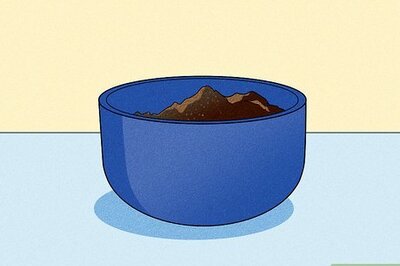



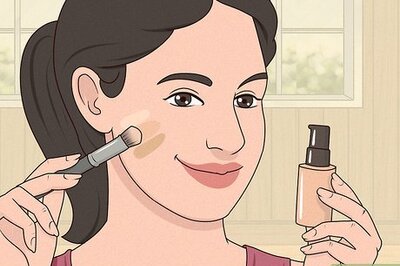



Comments
0 comment